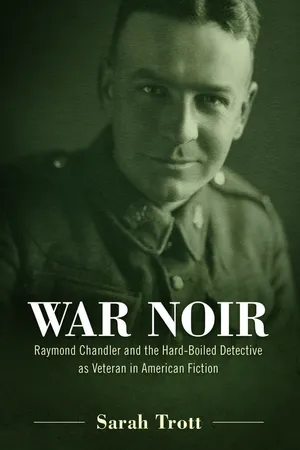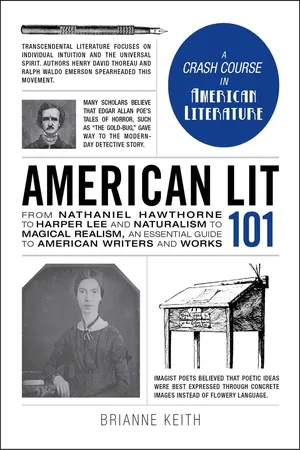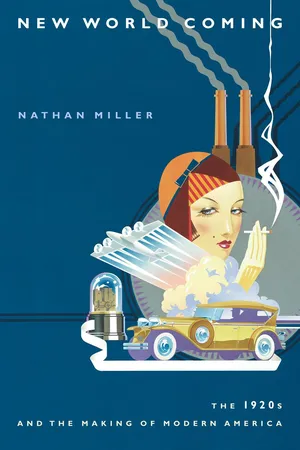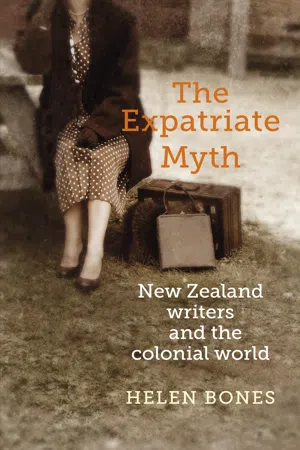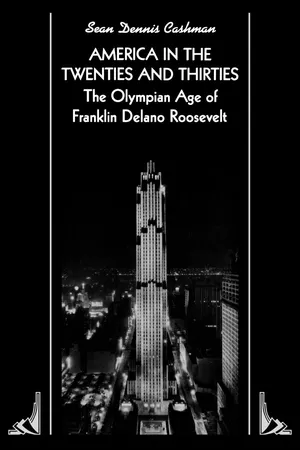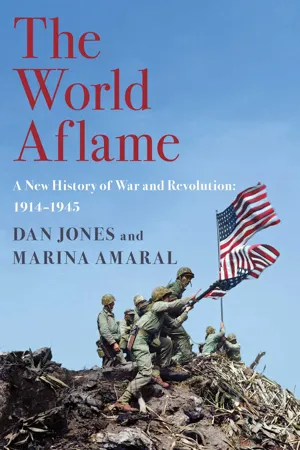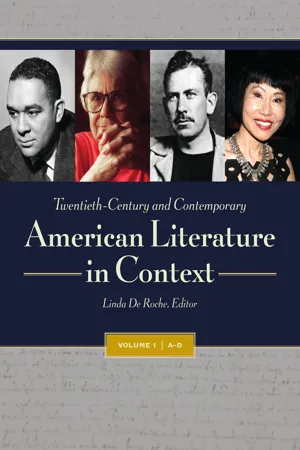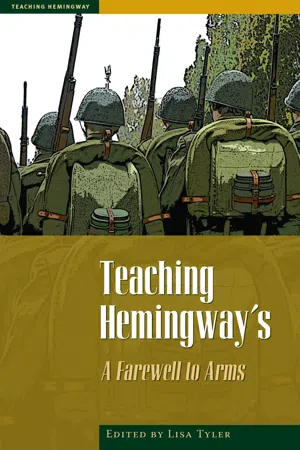Literature
Lost Generation
The "Lost Generation" refers to a group of American writers who came of age during World War I and felt disillusioned by the societal changes that followed. This term was popularized by Ernest Hemingway and encapsulates the sense of aimlessness and disillusionment experienced by the generation. The literature produced by these writers often reflects themes of alienation, disillusionment, and a search for meaning.
Written by Perlego with AI-assistance
Related key terms
Related key terms
1 of 4
Related key terms
1 of 3
11 Key excerpts on "Lost Generation"
- eBook - ePub
War Noir
Raymond Chandler and the Hard-Boiled Detective as Veteran in American Fiction
- Sarah Trott(Author)
- 2016(Publication Date)
- University Press of Mississippi(Publisher)
However, this evokes a further dilemma for studies of the Lost Generation since identifying writers of this literary set by genre subsequently becomes nonsensical and meaningless. By the 1920s the concept of genre had become increasingly blurred and imprecise, an impulse directly attributable to the consequences of the war and its aftermath. Writing about the soldiers returning from the First World War, Gertrude Stein first coined the expression “Lost Generation.” She wrote that “all of [the] young people who served in the war” returned to America a “Lost Generation” (qtd. in Lynn 333). This group of troubled individuals was identified by F. Scott Fitzgerald’s character Amory Blaine in This Side of Paradise (1920) as those who spoke for American youth: “Here was a new generation [ … ] grown up to find all Gods dead, all wars fought, all faiths in man shaken” (270). Michael Parish claimed that these returning soldiers were men who “struggled to define the relationship between their craft, their lives, and their place in society in the aftermath of the Great War.” He further explained: “They were disillusioned by the savagery of the war and the failure of peacemaking; they rebelled against the moral provincialism and boorishness of their own middle-class upbringing; they distrusted the institutions of mature capitalism and the nation’s dominant commercial culture” (184). Malcolm Cowley, however, tells us that the term “Lost Generation” is too narrow and restrictive and argues that a more accurate description of those writing in the interwar period is “the World War One generation” (vii). He explains that it was “the First World War that made … a generation, by changing their world and by giving them shares, as it were, in a rich fund of common emotions” (3). The war, he says, “gave them the feeling of having lived in two eras, almost on two different planets - eBook - ePub
American Lit 101
From Nathaniel Hawthorne to Harper Lee and Naturalism to Magical Realism, an essential guide to American writers and works
- Brianne Keith(Author)
- 2017(Publication Date)
- Adams Media(Publisher)
Interestingly, at the heart of modernism lay a very important irony: While there was excitement to move forward and leave old traditions and beliefs behind, there was also a sense of regret that traditions were lost. As a result, you can see writers creating works that both catapulted literature forward and works that more cautiously tried to re-envision traditions to preserve them in some way. Writers either reveled in the chaos or were anxious to put the pieces back together—while some managed to find humor in it all.Passage contains an image
The Lost Generation
The Roaring Twenties
“One generation passeth away, and another generation cometh; but the earth abideth forever . . . The sun also ariseth, and the sun goeth down, and hasteth to the place where he arose.” —EcclesiastesThe Lost Generation seemed an appropriate term for the twenty- and thirty-somethings who came of age after the war. Soldiers, witness to so much carnage, now returned home and felt like strangers to their own homes. Young people who didn’t go to war were just as disaffected—many of them went to Europe to escape the sense of fragmentation at home (also, the drinking age was lower).The American expatriate Gertrude Stein (1874–1946) was in many ways the literary “mother hen” of the Lost Generation. She counseled writers, gave them support, and put into motion some of the defining artistic philosophies of the era.A writer and intellectual herself, Stein left to live in Paris when she was young and stayed there for most of her life (though she never considered herself an expatriate—always an American first). She shared an apartment with her partner, Alice B. Toklas, that became a massive hub for writers, intellectuals, artists, and American expatriates. Pablo Picasso, who painted her portrait, and Ernest Hemingway, who immortalized her term “Lost Generation” in his novel The Sun Also Rises , were some of the stars who crossed Stein’s threshold.Stein even christened the Lost Generation: Supposedly, one day in Paris, Stein overheard her car mechanic tell his young workers, who weren’t going fast enough, “you’re all a Lost Generation.” For Stein, the term stuck.Gertrude Stein’s Style
Gertrude Stein had a radical writing style that in many ways captured the experimental spirit of the modernist era. Her writing aimed to revolutionize what the very function of a word - Available until 19 Sep |Learn more
Twentieth Century Paris
1900-1950: A Literary Guide for Travellers
- Marie-José Gransard(Author)
- 2020(Publication Date)
- Tauris Parke(Publisher)
6 The Lost Generation‘That’s what you are. That’s what you all are,’ Miss Stein said. ‘All of you young people who served in the war. You are all a Lost Generation.’(Ernest Hemingway)Eliot’s poem The Waste Land (1922) is a breakthrough in Modernist literature, expressing the futility and despair felt after 1918. For the generation of American and English writers like Hemingway, Ford Madox Ford and Dos Passos, who came of age during World War I, Paris represented everything their homeland was not. Those post-war years have been dubbed les années folles , the Jazz Age, the Roaring Twenties, but that apparent gaiety masked the continuing suffering of the so-called ‘Lost Generation’. These writers settled in Montparnasse on the Left Bank. They wrote in cafés by day, frequented clubs at night, drank without restriction, and enjoyed the city’s liberated way of life. They were preparing their own reaction to the war; it had made traditional writing styles inadequate, and a literary revolution was under way. Somerset Maugham puts into prose the lasting effect of wartime: ‘… you don’t know what experience he had in the war that so profoundly moved him. … I suggest to you that whatever it was that happened to Larry filled him with a sense of the transiency of life, and an anguish to be sure that there was a compensation for the sin and sorrow of the world.’ These young writers owed much to Sylvia Beach and her bookshop, Shakespeare and Company.‘My loves were Adrienne Monnier and James Joyce and Shakespeare and Company.’ Sylvia Beach (1887–1962) was fourteen when she arrived in Paris in 1901 with her father, a Presbyterian clergyman from Baltimore who was called to serve in Paris. The family returned to the US in 1906, but Beach was back in Paris in the spring of 1917 to study, as she had ‘a particular interest in contemporary French writing’. She stayed first at the Hôtel Beaujolais, 15 rue de Beaujolais, and then shared a flat with her sister in the Palais-Royal. During World War I she volunteered for relief work and joined the volontaires agricoles (agricultural volunteers), sharing their hard work picking grapes and grafting trees in Touraine, before working further afield for the Red Cross in Belgrade. It took her three full years to decide what to do with her life, but finally in 1919 she decided to settle in Paris permanently and to open Shakespeare and Company, a bookshop selling mainly British books at 8 rue Dupuytren in Saint-Germain-des-Prés. Since interest in American literature was growing in Paris, she added portraits of Edgar Allan Poe and Walt Whitman to those of Shakespeare and Oscar Wilde in her shop, which quickly became too cramped. In July 1921 she moved to larger premises at 12 rue de l’Odéon, which served as a lending library for the many customers who could not afford to buy books. For those away from home it was a godsend, a useful postal address, and somewhere occasionally to borrow money. The subscribers were dubbed ‘bunnies’, an invented word derived from the French word for subscriber: abonné . The bookshop was also an outlet for avant-garde publications like The Little Review , Broom and the Transatlantic Review - eBook - ePub
New World Coming
The 1920s and the Making of Modern America
- Nathan Miller(Author)
- 2010(Publication Date)
- Scribner(Publisher)
At her salons, she monopolized the writers while their wives and girlfriends talked to her tiny, ever watchful companion, Alice B. Toklas. “You are all a Lost Generation,” Stein told Hemingway one evening. “All of you young people who served in the war. You have no respect for anything. You drink yourselves to death.” This catchy bit of bombast was not original. Stein had picked it up from a French garage owner’s diatribe against a young mechanic who failed to take proper care of her beloved Model T. * In his fictionalized memoir of the Paris years, A Moveable Feast, Hemingway wrote that he angrily rejected the idea that a generation could judge the one that followed. As he walked back to his flat, he was still seething. “The hell with her lost-generation talk and all the dirty, easy labels,” he muttered. † Nevertheless, “a Lost Generation” became the unofficial badge of the literary generation of the Twenties because it so aptly evoked the alienation, disillusionment, and cynicism so fashionable during those years. Moreover, the postwar intellectuals relished its romantic image of doomed youth. But like all such labels, it was only partially true. While some young people drifted aimlessly and without purpose from bar to bed and bed to bar, others worked hard at establishing themselves as writers, poets, and artists. Besides, a generation that produced The Sun Also Rises, A Farewell to Arms, The Great Gatsby, Tender Is the Night, The Sound and the Fury, The Maltese Falcon, and the trilogy U.S.A. can hardly be said to be “lost.” Rather, as the poet Archibald MacLeish noted, the Twenties was “the greatest period of painting and music, literary and artistic innovation since the Renais-sance.” John Dos Passos captured the excitement of the Paris that greeted these young Americans - eBook - ePub
The Expatriate Myth
New Zealand Writers and the Colonial World
- Helen Bones(Author)
- 2019(Publication Date)
- Otago University Press(Publisher)
Introduction A Lost Generation?T he ‘literary expatriate’ is a character familiar to anyone versed in literary history, particularly the literary histories of the countries of the New World. Writers are given this label if they choose to live and write somewhere other than their country of origin, a common occurrence that tends to either be romanticised as a flight from an unpromising artistic environment or criticised as a rejection of national origins. The American writers who went to Paris in the 1920s (Gertrude Stein, Ernest Hemingway, Ezra Pound and so on) are commonly referred to as the ‘Lost Generation’1 – an appellation that manages at once to imply that their travel had a permanent and negative effect on American writing, and that this phenomenon involved pretty much everybody at that time (or at least everyone who claimed to be a writer).The model of literary expatriatism generally goes as follows: firstly, a would-be writer must grow up in (or be taken against their will to live in) a small town, ideologically challenged society or colonial outpost (and some places are more than capable of fulfilling all three categories) that is vastly inadequate to nurture such a talent. Consequently the only possible course of action is to leave for somewhere more promising – as the Australian writer Henry Lawson put it, to ‘go steerage, stow away, swim and seek London, Yankeeland or Timbuktoo’2 – with great haste. Secondly, this regrettable withdrawal from one’s native country results in the creation of an ‘expatriate’: a special category that implies that the writers and their potential contributions have been permanently lost, even though in most cases expatriatism was not permanent. In the Oxford History of New Zealand Literature, Lawrence Jones writes that the only realistic outcomes for aspiring New Zealand novelists between 1890 and 1934 were withdrawal into ‘silence’ or ‘expatriation’.3 He implies that expatriation was really another kind of silence, because it signalled a loss of literary talent for the country: the expatriate would no longer be contributing to the national canon. Jones also gives voice to a common binary division imposed on the literary past, between authors with a national focus and those with international interests: a division that did not exist in reality. This myth of necessary literary expatriatism, leading in most cases to ‘voluntary exile’, is an accepted and lamented part of many ex-colonial cultural nationalisms.4 - eBook - ePub
America in the Twenties and Thirties
The Olympian Age of Franklin Delano Roosevelt
- Sean Dennis Cashman(Author)
- 1989(Publication Date)
- NYU Press(Publisher)
11 REQUIEM, BUT NO PEACE The Lost Generation and the Arts Y OU ARE all a Lost Generation,” is the first of the two epigraphs to Ernest Hemingway’s novel, Fiesta, or The Sun Also Rises (1926). The remark is accredited to Gertrude Stein and this pithy observation has remained as the unofficial title for the dominant literary generation of the 1920s, although Hemingway subsequently regretted using the phrase and Gertrude Stein denied ever having uttered it. The writers of the Lost Generation were, strictly speaking, expatriates such as Hemingway himself, F. Scott Fitzgerald, Sherwood Anderson, and John Dos Passos, who all spent at least months, if not years, in Paris, but membership can be extended to include those writers who stayed at home and resisted the opportunity for exile with a comfortable bohemian life-style that Paris offered Americans owing to the strength of the dollar. However, in many ways, even those who stayed at home, such as Sinclair Lewis, Ring Lardner, and Eugene O’Neill, were in exile, internal exile. Writers were alienated by the culture of commerce that permeated the superficial, tawdry affluence of America in the 1920s. The epithet “Lost Generation” has survived because it evokes the themes of alienation, disillusionment, and cynicism with tradition, religion, and even literature itself that dominated the literature of the 1920s. Yet in many ways these negative attitudes also helped consolidate the beginnings of modernism in America’s written culture. The second epigraph to The Sun Also Rises, taken from Ecclesiastes, provides the novel with its title and is a poignant expression of Ernest Hemingway’s outward pessimism and nihilism: “One generation passeth away, and another generation cometh; but the earth abideth for ever. . . - eBook - ePub
The World Aflame
A New History of War and Revolution: 1914-1945
- Dan Jones, Marina Amaral(Authors)
- 2020(Publication Date)
- Pegasus Books(Publisher)
This Christmas photograph was taken a few years later; by this time, Fitzgerald had been discharged from the army and begun a career as a novelist and chronicler of the post-war age: a time variously known as the Roaring Twenties and the Jazz Age, whose young people were sometimes dubbed the Lost Generation. His novels during the 1920s included This Side of Paradise, The Beautiful and Damned and The Great Gatsby. Today, several of his works are considered canonical in American literature, and there has been growing critical admiration for Zelda’s only published novel, Save Me the Waltz, as well as her paintings. The world that Scott and Zelda Fitzgerald inhabited, chronicled and – in a sense – created had been profoundly shaped by the experiences of the First World War. For well-heeled Americans and Europeans, the 1920s oozed hedonism: a devil-may-care cocktail of jazz, parties, flapper dresses and art deco sheen, all helped by a bullish US economy. Behind this glamorous exterior, however, lurked great troubles. The world was at peace, but it was not at ease. The same was true in microcosm for the Fitzgeralds. Both drank heavily and recklessly; their marriage was plagued by fights, jealousies, serious mental and physical health issues, and acute financial woes. This paradox between the glamour of the post-war age and the miseries that endured was an important theme for many of the greatest artists and writers who emerged during the 1920s. Many of these creative spirits – including the Fitzgeralds – congregated in Paris. They included the muscular American novelist Ernest Hemingway and the poets T. S. Eliot and Ezra Pound. The key figure in this circle was Gertrude Stein: a writer and art collector who, before the war, had been an important patron of Pablo Picasso - eBook - ePub
Public Schools and The Great War
The Generation Lost
- Anthony Seldon, David Walsh(Authors)
- 2013(Publication Date)
- Pen & Sword Military(Publisher)
Chapter 10 The Lost Generation‘The loss sustained by the war can only be described as the wiping out of a generation.’ Thus spoke the Bishop of Worcester when dedicating the war memorial at Malvern College in July 1922: ‘Those who are left have to take up a double duty. There remains a great task of recovery, to see that everything is done to make the world better, purer, happier and more united. Those who died had the vision, those who live have the work to do.’1 This chapter looks at the ‘Lost Generation’ from the public schools, those who lost their lives and those whose lives were shattered forever by the war, a generation of men who, in Remarque’s words, ‘even though they may have escaped the shells, were destroyed by the war.’2 We know that about 900,000 British and Dominion forces died in the war, that just over two million were wounded – and that three million survived unscathed. We will never know the depth of the scars and suffering that these deaths created for their loved ones in Britain and elsewhere, nor the scale of the family lives disrupted, saddened or otherwise diminished.3 The empty chair at the table, the tender relationships destroyed forever, the haunting memories, the grieving and the nightmares: these are the unquantifiable legacies. In his haunting contemporary novel Birdsong, Sebastian Faulks (Wellington College) evokes this ‘unknown loss’, when Captain Price reads the roll-call after the company has been in action on the Somme: ‘Price hurried from one unanswered name to the next … Names came pattering into the dusk, bodying out the places of their forebears, the villages and towns where the telegrams would be delivered … with the children who would have been born, who would have grown or worked or painted, even governed, left ungenerated in their fathers’ shattered flesh that lay in stinking shell-holes in the beet-crop soil’.4 - eBook - ePub
After the Lost Generation
A Critical Study of the Writers of Two World Wars
- John Watson Aldridge(Author)
- 2019(Publication Date)
- Arcole Publishing(Publisher)
The story of what happened during those years abroad has been written and rewritten many times over. The process of exile was complete. The young men came to Paris. With their wives and children, cats and typewriters, they settled in flats and studios along the Left Bank and in the Latin Quarter. They took jobs as foreign correspondents for American newspapers, sent back social gossip and racing news; wrote book reviews, magazine articles, and stories; bet on horses, gambled, borrowed, and begged; did anything to keep alive and to prolong the show. If we can believe the stories, they were drunk much of the time, traveled considerably, and had a great many love affairs. They also managed to get an impressive amount of good writing done. The early work of Hemingway, Fitzgerald, Dos Passos, Cummings, and others bears witness to the fact. Betweentimes, when they were not drinking at the cafés, partying, or making love, they talked a lot and did a certain amount of thinking. At about this time, some of them discovered Gertrude Stein, and she, in turn, discovered among them talents worthy of her guidance. It was she, perhaps more than any other, who taught them how to make the most of their “lostness,” how to develop, as had Sherwood Anderson, an idiom that would be true of their time and truly their own.Then, as the new writing began to appear, new little magazines began springing up to accommodate it. Their titles, Broom, transition , This Quarter, Secession , were indicative of their editorial policies. Fresh currents of energy were breaking out everywhere, everywhere the accent was on the new and different, the departure from old forms and techniques, the rebellion. The years of European apprenticeship were paying off in a vigorous new literature, a literature written so compellingly, with such a tragic sense of loss, that it seemed to describe the predicament of all contemporary humanity. For writers like Hemingway, Dos Passos, and Cummings, the experience of their generation—the bitterness, the monumental disbelief which the war had taught—was the only tradition. They had been uprooted from the world of their childhood with its unwavering ideals and trusts and plunged into the world of Caporetto, the Western front, the “enormous rooms” of the war; and they had awakened from the war only to find themselves in another and even more fantastic world—that of Dada, surrealism, and Gertrude Stein. If they understood only the immediate present and past, if they worshiped only the gods of sex, liquor, violence, and art, it was because they had known nothing else. Life for them would forever after be perceived and lived within the frame of the war and the emotions of war.Thus, while Mencken and Lewis were still discovering the banalities of life back home, the young men who had acted on their indictments and fled to Europe were discovering a new language which would express themselves and their own unique experience. In Gertrude Stein the demands of a persistent originality had led to greater and greater indulgence in pure technique. Hers was an art deprived of its objective basis, lost somewhere in the convolutions of its careless meaning. The search for ever-widening suggestiveness carried the older Joyce into the limbo of dream, the ultimate subjective state beyond the necessity of words. But the young Hemingway’s search for the “real thing,” “the exact sequence of motion and fact which made the emotion,” ended in a prose that was as crystal-clear as brook water, that was written “without tricks and without cheating,” with nothing that would “go bad afterwards.” Hemingway in those years was the American compromise with Dada. He was everybody’s example of an American who combined the best that was in America with the zeal and discipline of the French. He was coarsely, robustly healthy in the tradition of Mark Twain and Sherwood Anderson, but he was never vulgar, almost never naïve; and in his passion for exactitude, le mot juste, - eBook - ePub
- Linda De Roche, Linda De Roche, Linda De Roche(Authors)
- 2021(Publication Date)
- ABC-CLIO(Publisher)
Hemingway, Ernest (1899–1961)Ernest Hemingway is arguably the most famous American writer of the twentieth century. His books have never gone out of print, and his image is still used to sell furniture, sunglasses, and cocktails. Best known for his revolutionary innovations in literary style, he is also one of the writers associated with the Lost Generation of young men and women disillusioned by World War I (1914–1918), primarily expatriates, who settled in Europe, primarily Paris, in the 1920s. Indeed, it was to Hemingway that the writer Gertrude Stein issued her famous pronouncement, “You are all a Lost Generation,” which served as one of the epigraphs of his 1926 novel of that generation, The Sun Also Rises.Born on July 21, 1899, to Clarence “Ed” Hemingway, a physician, and Grace Hall Hemingway, a music teacher, Hemingway grew up in Oak Park, Illinois, a Chicago suburb, but his family summered at a cottage in northern Michigan, a locale that inspired some of his best short fiction. He first showed evidence of his interest in writing when he wrote for the Oak Park High School newspaper, Trapeze, and yearbook, Tabula. Instead of going to college, he went to work for the Kansas City Star as a cub reporter.Eager to participate in World War I, Hemingway volunteered for the Red Cross when he was eighteen years old. He served briefly as an ambulance driver but on July 8, 1918, was badly wounded in the leg while handing out cigarettes and chocolate to Italian soldiers. He recuperated at a hospital in Milan, Italy, where he fell in love with his twenty-six-year-old American nurse, Agnes von Kurowsky. Two months after he returned home, she jilted him by letter. Their relationship inspired his 1929 novel A Farewell to Arms. It was also dramatized in the 1996 film In Love and War.Hemingway married Hadley Richardson in 1921, and soon afterward they traveled to Paris, where he reported for the Toronto Star and became associated with the Lost Generation. The couple had one child, John, whom they nicknamed “Bumby.” During their marriage he published his first book, the 1925 short-story collection In Our Time. Hemingway wrote of his years in Paris in both his first novel, The Sun Also Rises, and a posthumously published memoir, A Moveable Feast (1964). Unhappy with his publisher, he wrote The Torrents of Spring (1926), a parody of Sherwood Anderson’s work, accurately believing that Liveright would refuse to publish it on the grounds that it disparaged their star writer. When Liveright did indeed reject the novella, Hemingway was then legally free to take both it and his eagerly awaited novel The Sun Also Rises - eBook - ePub
- Lisa Tyler(Author)
- 2013(Publication Date)
- The Kent State University Press(Publisher)
Farewell based not on the date of its publication but on the date of its setting in World War I Italy, before they read T. S. Eliot’s poetry of despair and F. Scott Fitzgerald’s postwar story of the American Roaring Twenties. Students need, I think, to understand the impact of the Great War in order to understand the poetry and novels that reflect the disillusionment and despair in postwar modernism. As one commentator remarks, “The twentieth century began on June 28, 1914. On that day Europe plunged into a vortex of metahistorical change called the Great War. What emerged four blood-soaked years later was a world utterly different from the one people had known for centuries. We would recognize it as the world we live in today… . Suspicion of authority, doubts about absolutes, irony and cynicism all defined modernity, in life and art” (Zakaria 91).Another reason for placing Farewell before other modernist works is Hemingway’s use of Frederic Henry as a retrospective narrator of his story. Students often do not catch on to the subtleties of Frederic as narrator and the difference the time of narration can make in interpreting the actions of a character in a novel. Students voice their confusion as they are reading the novel, claiming, “I can’t get into it. It seems to move so slowly. I don’t understand Frederic and Catherine’s relationship.” Leading students to see Frederic’s depiction of himself through his telling of the story awakens their ability to read more actively. Their increased awareness of the importance of narrative perspective will also aid their reading when they encounter Eliot’s multiple narrative voices in The Waste Land and Nick Carraway’s complex retrospective narration of the events in The Great Gatsby, which he relates from others’ accounts and takes part in himself. Studying Farewell
Index pages curate the most relevant extracts from our library of academic textbooks. They’ve been created using an in-house natural language model (NLM), each adding context and meaning to key research topics.
Explore more topic indexes
Explore more topic indexes
1 of 6
Explore more topic indexes
1 of 4
